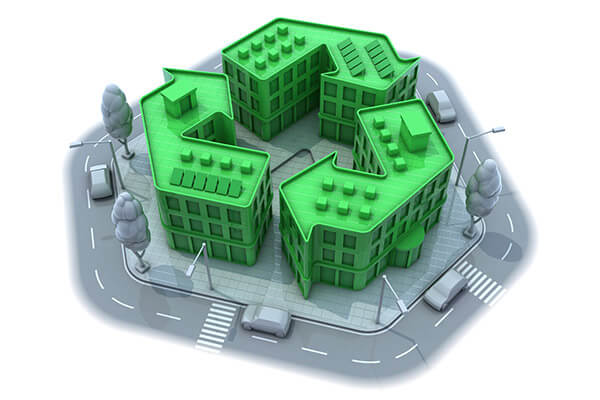In this three part series, we bring to you the latest trends in the 'green' transformation taking place all over the world; our focus being green and sustainable buildings.
One of the significant contributors to environmental change is the real estate industry. Commercial and residential buildings emit 40% of the total greenhouse gas emissions along with discharging equal quantities of waste, consume 40% of global energy, 25% of global water and 40% of global resources. Even though we all require buildings for living and working, it is clear that we just don't need huge and beautiful buildings anymore; what is required is the utilization of sustainable development technologies for the construction of buildings - Green buildings (green and sustainable being often used interchangeably). Green building concept aids in efficiency and minimizes energy along with lowering the impact of all other environmental factors during the building's life cycle: design, construction, procedure, preservation, restoration and demolition. The top 10 sustainable buildings which are currently in UK, US and China, use maximum renewable energy resources. Others need to follow their lead.
Benefits:
Tangible benefits of such buildings can be seen in operational savings, energy and water efficiency and waste reduction. Green buildings are usually around 25-30% more energy efficient; gold rated buildings around 37% more efficient. They utilize 20-30% less water than conventional buildings; and 70-100% of used water is recycled and reused for air conditioning and landscaping. Green buildings also recycle the construction and demolition waste, and reuse it in their buildings, thus reducing waste by around 50%.
The intangible benefits include cleaner air and natural light (75-90%), better ventilation, and exposure to less toxic interiors as low-emitting adhesives, wood and paints (lesser wood usage implies that trees are planted and forests are not completely demolished). Also, the decreased operating cost over one and five years seems to be the driver for green building growth along with the longer payback time for green investments.
Costs:
Worldwide, it is being perceived that the operational costs savings in comparison to traditional ones will be around 14% over five years, and 13% for green and retrofit projects. For green retrofits and renovations, the asset value and building value was expected to increase around 7% (median). The savings yielded from undertaking such projects showed a remarkable 15% (one year),while for people with high involvement, savings could increase up to 35% (five years).




Source: www.fidic.org
Motivation grounds differ:
Social reasons for going green have an impact in various countries. As per a survey, encouraging sustainable business practices was high in US, UK and Mexico followed by Singapore and Colombia. Creating a sense of community and healthier neighborhoods was the trigger in India, Saudi Arabia and Colombia. It increased worker productivity in Saudi Arabia, Mexico, Germany and South Africa. It supports the domestic economy in Australia, Saudi Arabia, Singapore and India; and was aesthetically pleasing to countries such as Australia, China and Brazil.
The most important environmental reason for going green is reducing energy consumption which has the highest impact in Singapore, US, Germany and Poland. Protecting natural resources seemed to be the basis in Colombia, Australia, China and India, while reducing water consumption was the leading factor in South Africa, Saudi Arabia and Brazil. Countries that wish to contribute to lowering greenhouse emissions are UK, Mexico, Singapore and Australia. And finally improving air quality is the foremost reason in China, India, Poland and Mexico.
Obstacles:
Higher investment is a major impediment to the global green market growth, with a recent study showing it as one of the main causes in as many as 11 countries including US, Mexico and productivity in Saudi Arabia, Mexico, Germany and South Africa. It supports the domestic economy in Australia, Saudi Arabia, Singapore and India; and was aesthetically pleasing to countries such as Australia, China and Brazil.
The most important environmental reason for going green is reducing energy consumption which has the highest impact in Singapore, US, Germany and Poland. Protecting natural resources seemed to be the basis in Colombia, Australia, China and India, while reducing water consumption was the leading factor in South Africa, Saudi Arabia and Brazil. Countries that wish to contribute to lowering greenhouse emissions are UK, Mexico, Singapore and Australia. And finally improving air quality is the foremost reason in China, India, Poland and Mexico.
Obstacles:
Higher investment is a major impediment to the global green market growth, with a recent study showing it as one of the main causes in as many as 11 countries including US, Mexico and Colombia. Lack of public awareness and political support seemed to be another deterrent seen by countries such as India, Poland Colombia and Brazil. Further lack of incentives also seemed to be an obstacle in countries such as Colombia, Poland and Brazil. And lastly, the fight for perception of green being only for high end projects loomed over countries such as Australia, UK and Singapore. Other obstacles often noticed have been companies not able to establish the business situation due to split between capital and operating costs, dearth in trained/educated green building professionals and less/nil access to capital.
In the next series, we take a look at the trends in India and worldwide.
*All data courtesy Dodge report 2016
